
Pacific Railroad Society and LA Rail are proud to announce a special train from Los Angeles over Cajon Pass to Barstow in connection with Railfest 2009 at the Harvey House at Barstow. This train will leave Los Angeles Union Station at 8:00 am Saturday, October 17th. Passengers may also board the train at Fullerton at 8:40 am. This special train will consist of Amtrak coaches, and four private railroad cars including: open platform business car "Tioga Pass", lounge car "Overland Trail", sleeper "Salisbury Beach" and dome-diner "Silver Splendor". Western America Railroad Museum at Barstow sponsors Railfest each fall which includes modular train layouts courtesy of Pacific Coast Region of NMRA, craft and hobby vendors and tours of the restored Harvey House at Barstow. Admission to the rail museum and the Route 66 Museum will be included in the train passengers' fare. The volunteer staff of the railroad museum will prepare and serve a luncheon (included in your train fare) to all train passengers on the park area in front of the Harvey House. Make your reservations early. Only 6 coaches will be available. First class space on the private cars will sell out quickly.
When this trip was announced, I decided it would be fun to do aboard the "Tioga Pass". Winston Walker decided his family would also participate, but aboard the "Overland Trail". Thus, we could all drive to LAUPT together and meet in Barstow. Mrs. Walker's health forced her to cancel, but I found that my old and dear friend Bill Compton could come and he would meet us at LAUPT the morning of the trip to buy his ticket.
I was up early that Saturday morning and waited for Winston to pick me up for the quick drive to LAUPT.

The sign in the tunnel to alert our riders to where the train was boarding.
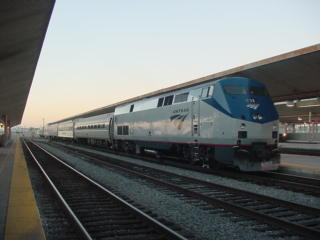
The Barstow Flyer waiting for its passengers.
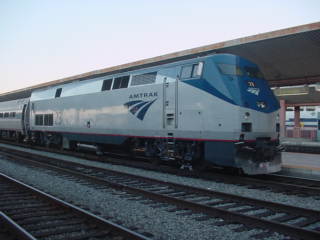
Amtrak P42DC 23 wouuld be pulling our special train to Barstow.

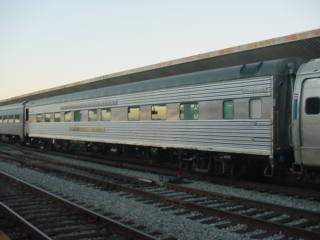
Boston & Maine 6-4-6 sleeper 34 "Salisbury Beach" PPCX 800257 built by Pullman-Standard in 1954 for use on the State of Maine overnight express from Grand Central Terminal in New York to Concord, New Hampshire. The car's six roomettes feature cut-away beds and permanent sinks. The six bedrooms included private annexes and an en-suite capability. Owner and restorer, Tom Pearson, has owned eleven other cars before the Salisbury Beach including a diner- lounge car and several baggage cars. He bought the car in 1989, and brought it to California from St. Louis off the Sunset Limited, in February 1990. In restoring rail cars, as with restoring classic automobiles, finding original parts is a challenge, but part of the enjoyment of authentic restoration. The car has been all refurbished except for upholstery and carpet, which will soon be replace with original pullman upholstery. Original steam heat has been replaced with electric baseboard heaters. Tom has updated the car by converting one restroom to a shower and another to a dressing room, leaving two restrooms.
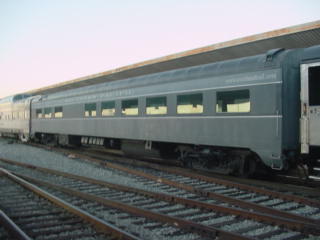
Southern Pacific 39 seat club-lounge-barbershop 2981 "Overland Trail" PPCX 800633 built by Pullman Standard in 1949. It was specifically ordered in October 1947 for the San Francisco Overland, a train jointly operated by the Southern Pacific, Union Pacific and the Chicago & North Western railroads between Chicago and Oakland (San Francisco). The 2981 served faithfully, racking up around 5 million miles for the Southern Pacific during its railroad career. However, as the fortunes of passenger trains waned in the 1950's and 1960's, so too did the glory of this stylish railcar, when in October 1966, the beautiful lounge of 2981 was stripped and converted into a dance floor. The Southern Pacific (wanting to keep idled onboard service crews working during the winter), along with the Reno Chamber of Commerce, started the Reno Fun Train (a winter time "gamblers special") which ran between Oakland and Reno, bringing revellers, who otherwise, would not make the drive from the Bay Area over the treacherous Donnor Pass, to Reno.
Amtrak was created on May 1st, 1971 to "rescue" the American passenger train (some would say to administer its burial), which was in a death spiral and no longer any competition to the commercial airlines or the automobile. The 2981 was purchased by Amtrak in 1973 and numbered Amtrak 3500. She finished her railroad career, still assigned to the Reno Fun Train serving as a bar/dance car into the late 1970's. The car transitioned to private hands after Amtrak retirement and spent a decade as a derelict on various railroad spurs under several owners. Fortunately for the 2981, a new chapter has been written for this glorious car. Once again adorned in authentic railroad colors, she has been given the name Overland Trail and has undergone extensive mechanical, structural and cosmetic restoration to return her to the rails as a classic form of travel, suitable for the stylish and sophisticated, or for those simply wishing to relive a bygone era.
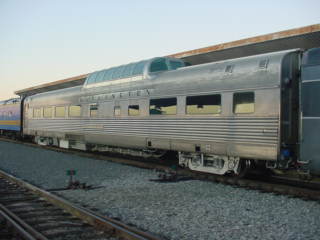
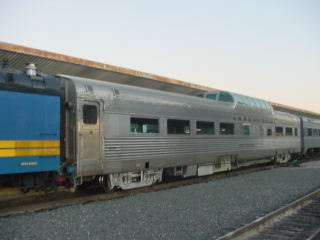
LA Rail Vista-Dome lounge-dining car "Silver Splendor", nee Chicago, Burlington and Quinicy 4735 "Silver Buckle" built by Budd Company in 1956. It was part of the last two complete conventional train sets to be ordered new in the pre-Amtrak era and traveled over 4.5 million miles on a daily basis between Chicago and Denver until 1980. With standard coach seating for 50 and 24 seats up in the dome, "Silver Buckle" provided fast and comfortable service for budget- minded patrons until Amtrak's bi-level Superliners arrived. Officially retired in 1981, the car spent time in storage at Oakland, California and Beech Grove, Indiana before being auctioned off by Amtrak to a railcar shop owner in 1993. In 1997, the current owners, Heidi and John Caestecker, purchased the car in the Midwest and moved it to Fullerton with the intent of restoring it to operating condition as a luxurious dome-diner-lounge. Dining capacity will be 24 at tables upstairs and another 24 in the long end of the lower level. A cocktail lounge seating 10-12 will be featured in the short end, with kitchen and restrooms under the dome.
The stylishly appointed Vista Dome Lounge-Dining Car is the ultimate in land cruising excellence. The graceful glass-enclosed rooftop observation room provides unparalleled views in all directions. With day trip and dining capacity for up to 74 guests you travel elegantly while gliding along immersed in breath-taking landscapes. Attentive onboard staff will pamper you with respectful and lavish personal service of a long gone era in railway history. With standard coach seating for 50 and 24 seats up in the dome, "Silver Buckle" provided fast and comfortable service for budget-minded patrons until Amtrak's bi-level Superliners arrived. Officially retired in 1981, the car spent time in storage at Oakland, California and Beech Grove, Indiana before being auctioned off by Amtrak to a railcar shop owner in 1993.
In 1997 the current owners, Heidi and John Caestecker, purchased the car in the Midwest and moved it out to Fullerton, California with the intent of restoring it to operating condition as a luxurious Dome-Diner-Lounge. Dining capacity will be 24 at tables upstairs and another 24 in the long end of the lower level. A cocktail lounge seating 10-12 will be featured in the short end, with kitchen and restrooms under the dome.
"Silver Splendor" wa making its maiden post-restoration trip.

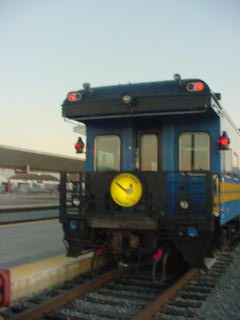
Private car "Tioga Pass" PPCX 800693 built by Canadian National in 1959. The car was part of an order for 12 similar cars designed for railroad executives. Originally number 23, and later number 93, "Tioga Pass" spent most of its life in Edmonton, Alberta. There it served the Vice President of the Mountain Region. Records show the car traveled all over Canada, providing some 30 years of faithful service. By the early 1990s, though, the car was largely redundant and seldom used. Like the passenger trains on which it used to hitch a ride, the automobile and airplane offered quicker and more convenient transportation in today’s fast-paced corporate world.
In 1992 Canadian National decided to sell the car, and a local businessman in Barstow, California named Rutherford P. "Rudy" Hayes bought it sight unseen because, as he put it, "I always just wanted one." In an epic trip, the car travelled from Edmonton to Barstow in January 1993. Through fierce cold and driving blizzards, the passengers stayed warm inside. Its new owner was like a proud father, pronouncing the car was all he ever thought it would be. Unfortunately, Rudy never got the chance to travel on his new car. He died of a heart attack only months after it was delivered. The car sat, forlorn and neglected in front of the Harvey House train station in Barstow for several years.
Aronco Leasing Company purchased the car in 1997 from the Hayes estate. A victim of benign neglect, numerous repairs and upgrades were needed before the car could be used again. Starting in 2002, the Tioga Pass has undergone the most extensive restoration since its construction. An exhaustive examination of all of the major mechanical components of the car was undertaken, including the wheels, suspension, couplers, and airbrakes. This thorough examination allows the car to be considered as good as new. At the same time, a number of upgrades were made to allow the car to operate behind Amtrak trains, such as installation of heavy-duty power cabling and signal and communications wiring.
With my ticket, I could ride in either "Tioga Pass" or "Silver Splendor".
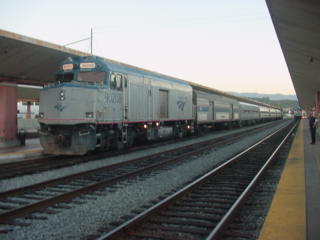
Pacific Surfliner 799 was ahead of our train waiting for its 7:30 AM departure time for San Luis Obispo. Bill arrived just after 7:15 AM and the Southwest Chief a few minutes later. We all boarded our cars and waited for the 8:00 AM departure, which was on time.
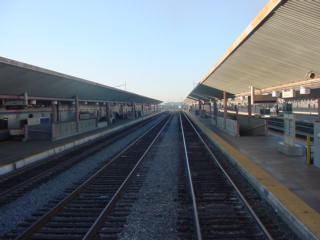
Our train leaving LAUPT.
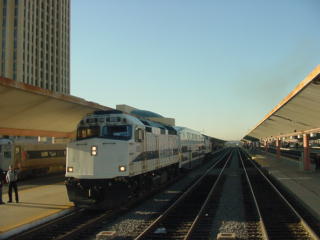
The Metrolink Movie Train, which was being used in the filming of "Under Siege 3" was at the station as we departed.
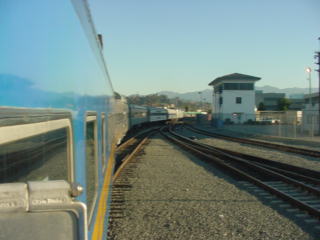
Passing Terminal Tower.

A Pacific Surfliner consist was being brought into LAUPT.

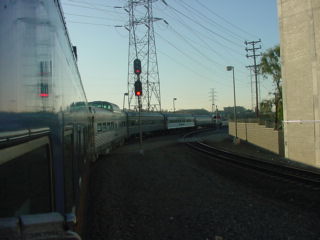
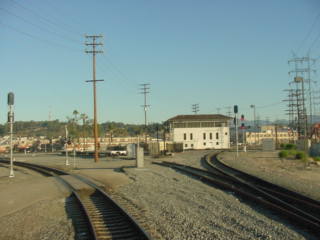
Curving south at Mission Tower.
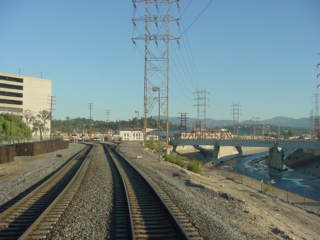
The train would run along the Los Angeles River for the first few miles.
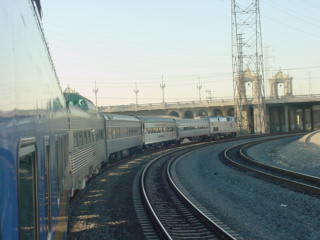
Making our way to the first road bridge across the Los Angeles River that we would pass under along the west bank.
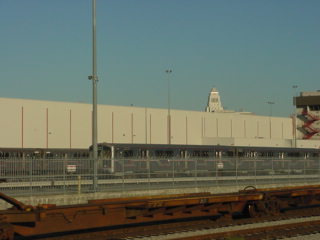
The Los Angeles Metro yard.
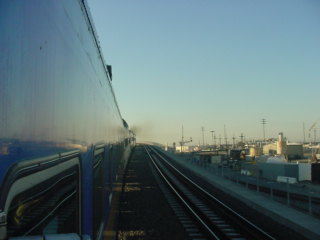
A few minutes later we climbed the flyover over the Alameda Corridor and Los Angeles River.

Santa Fe 4-8-4 3751, which some people had hoped would pull this trip but that was not possible.
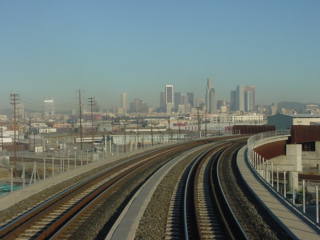
The Los Angeles skyline.
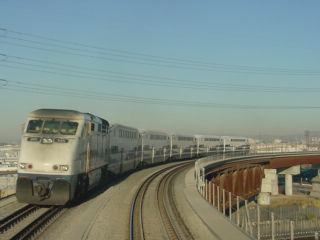
Metrolink 653 heads to Los Angeles Union Passenger Terinal.


CP Soto where we left Metrolink trackage for BNSF's San Bernardino Subdivision.
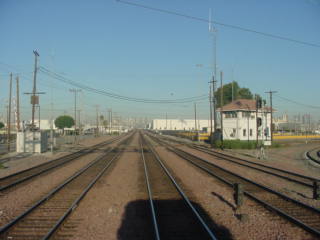
Hobart Tower.
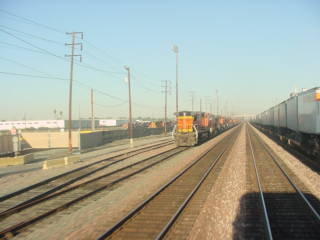
A few minutes later we passed over 100 stored BNSF locomotives.

The three track mainline narrows to two tracks at CP Serapis.
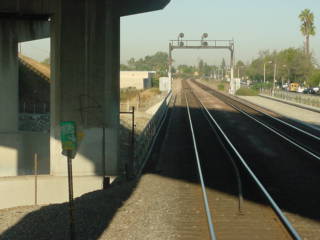
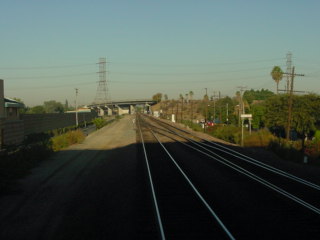
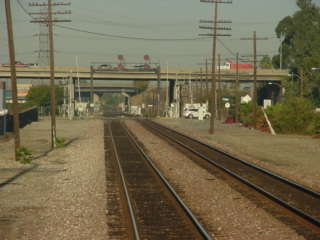
Passing trough DT Junction.
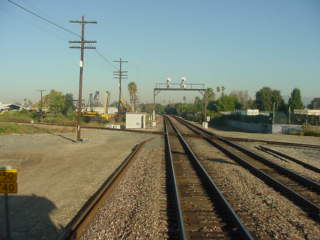
The Union Pacific crossing at Los Nietos.
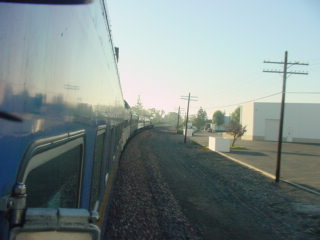
Curving towards Santa Fe Springs.
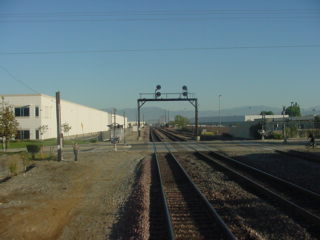
The signal bridge at Lakeland Avenue which would be lost when a third track is installed through this area.

It was a nice clear morning.
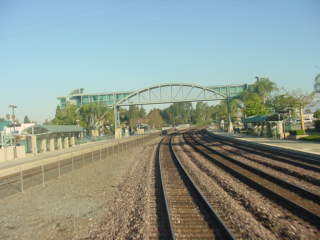
The Norwalk Metrolink station.

Work on the triple track along here is taking place.

CP Valley View.

Pacific Surfliner 763 on its way to Goleta.
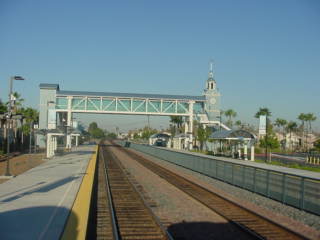
The Buena Park Metrolink station.
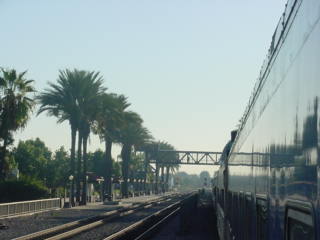
A few minutes later we arrived at Fullerton, our only passenger stop of the morning.
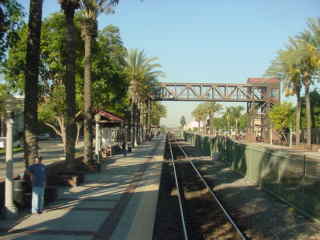
Our train departed Fullerton on its way to Barstow.
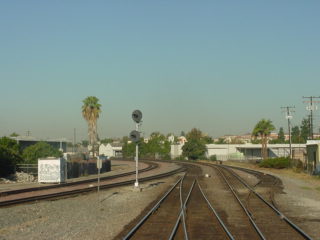

Fullerton Junction, where Metrolink's San Diego Subdivision leaves the BNSF mainline.

The intermediate signal between Fullerton and Atwood.
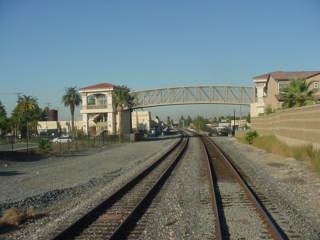
The pedestrian bridge at Placentia.
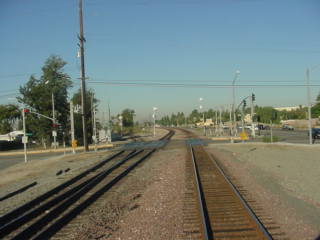
Atwood, the junction with the Metrolink line to Orange. We were called in for a short meeting, thus I missed the good pictures of our train on Horseshoe Bend.
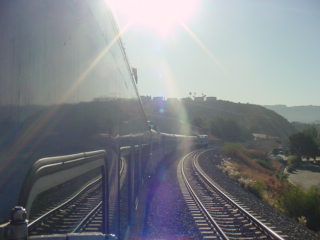
The train coming out of Horseshoe Bend in Santa Ana Canyon.
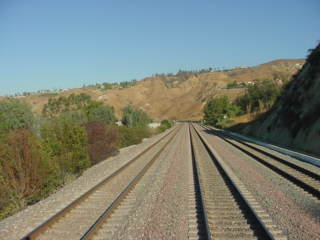
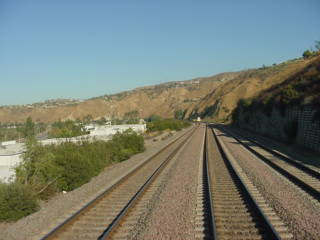
Looking back towards Horseshoe Bend.

Passing the homes in Santa Ana Canyon.

The last active orange grove along a rail line in Orange County.
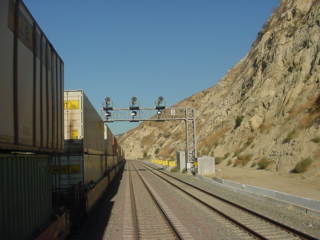
An intermediate signal near the east end of Santa Ana Canyon.
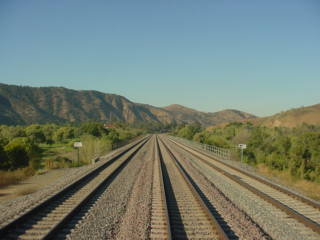
Our train crossed the Santa Ana River.

Corona West Metrolink station.

The former Santa Fe Corona station built in 1937.
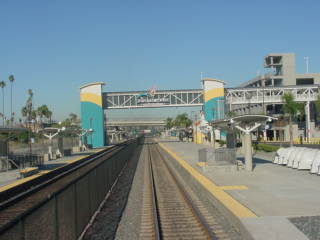
Corona-North Main Metrolink station.
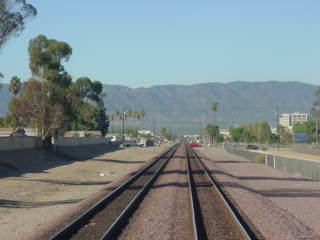
I did say it was a beautiful clear day as we headed east through Home Gardens.
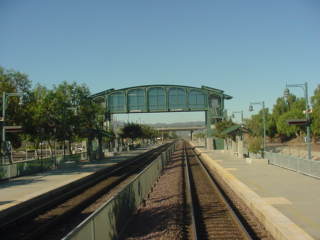
Riverside-La Sierra Metrolink station.

Site of night-time track work.
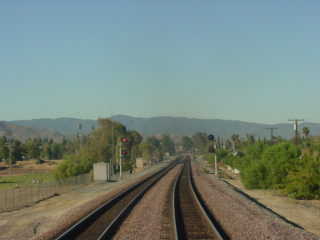
A great view looking back.
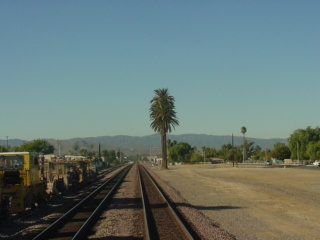
The train passed through Casa Blanca.
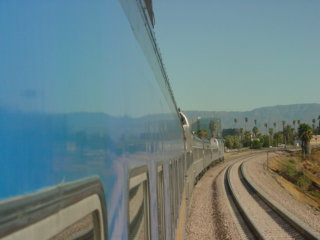
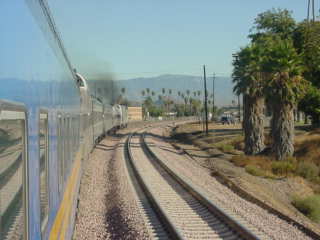
Curving into west Riverside.

West Riverside, where the former Los Angeles and Salt Lake Route, now Union Pacific, joins the BNSF mainline for their run to Daggett.

Metrolink 653 arrived at Riverside.

The Riverside Downtown Metrolink station.

The former Santa Fe Riverside station built in 1927.
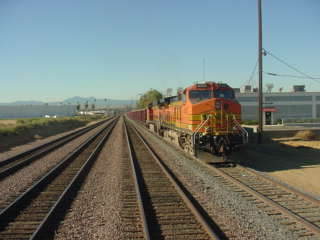
A BNSF ballast train.

Highgrove, where the line to Perris and Hemet takes off from the BNSF mainline. We came to a red signal and stopped.
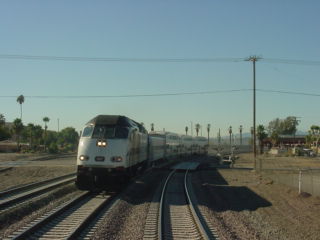
Metrolink 357 on its way to San Bernardino and Los Angeles.

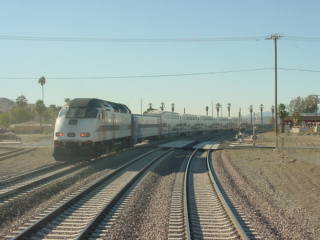
Metrolink 859 bound to Oceanside from San Bernardino.

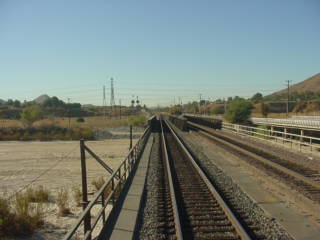
Crossingd the Santa Ana River.
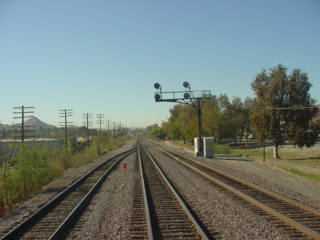
West Colton on the BNSF San Bernardino Subdivision.
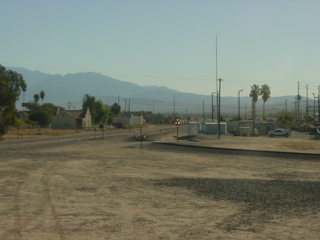

Our train then crossed the Union Pacific's Sunset route at Colton.